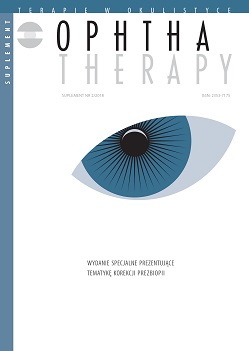Surgical methods for correcting presbyopia
Main Article Content
Abstract
In the recent years a significant development in surgical methods for correcting presbyopia is observed. Monovision is commonly applied in corneal refractive surgery and lens surgery, in order to induce anisometropia. In corneal refractive surgery correction of presbyopia can be achieved with micro- or mini-monovision, creating a multifocal profile or by increasing depth of focus due to induction of spherical aberration. In lens surgery mono-, bi-, tri and multifocal refractive or diffractive lenses are used, including extended depth-of-focus lenses. Another potential option is refractive lens exchange or implantation of a phakic intraocular lens, particularly in patients with a high refractive errors.
Downloads
Article Details

This work is licensed under a Creative Commons Attribution-NonCommercial-NoDerivatives 4.0 International License.
Copyright: © Medical Education sp. z o.o. License allowing third parties to copy and redistribute the material in any medium or format and to remix, transform, and build upon the material, provided the original work is properly cited and states its license.
Address reprint requests to: Medical Education, Marcin Kuźma (marcin.kuzma@mededu.pl)
References
2. Finkelman YM, Ng JQ, Barrett GD. Patient satisfaction and visual function after pseudophakic monovision. J Cataract Refract Surg 2009; 35(6): 998-1002.
3. Zhang F, Sugar A, Arbisser L et al. Crossed versus conventional pseudophakic monovision: Patient satisfaction, visual function, and spectacle independence. J Cataract Refract Surg. 2015; 41(9): 1845-54.
4. Hayashi K, Yoshida M, Manabe SI et al. Optimal amount of anisometropia for pseudophakic monovision. J Refract Surg. 2011; 27(5): 332-8.
5. Luft N, Siedlecki J, Sekundo W et al. Small incision lenticule extraction (SMILE) monovision for presbyopia correction. Eur J Ophthalmol. 2018; 28(3): 287-93.
6. Lindstrom RL, Macrae SM, Pepose JS et al. Corneal inlays for presbyopia correction. Curr Opin Ophthalmol. 2013; 24(4): 281-7.
7. Jacob S, Kumar DA, Agarwal A et al. Preliminary Evidence of Successful Near Vision Enhancement With a New Technique: PrEsbyopic Allogenic Refractive Lenticule (PEARL) Corneal Inlay Using a SMILE Lenticule. J Refract Surg. 2017; 33(4): 224-9.
8. Alió JL, Pikkel J. Multifocal Intraocular Lenses: Neuroadaptation. In: Alió JL, Pikkel J (ed). Multifocal Intraocular Lenses: The Art and the Practice. Springer International Publishing 2014: 47-52.
9. de Silva SR, Evans JR, Kirthi V et al. Multifocal versus monofocal intraocular lenses after cataract extraction. Cochrane Database Syst Rev. 2016. https://doi.org/10.1002/14651858.CD003169.pub4.
10. Gimbel HV, Sanders DR, Raanan MG. Visual and refractive results of multifocal intraocular lenses. Ophthalmology 1991; 98(6): 881-7; discussion 888.
11. Javitt JC, Wang F, Trentacost DJ et al. Outcomes of cataract extraction with multifocal intraocular lens implantation: functional status and quality of life. Ophthalmology. 1997; 104(4): 589-99.
12. Mester U, Vaterrodt T, Goes F et al. Impact of personality characteristics on patient satisfaction after multifocal intraocular lens implantation: results from the “happy patient study.” J Refract Surg. 2014; 30(10): 674-8.
13. Alio JL, Simonov A, Plaza-Puche AB et al. Visual Outcomes and Accommodative Response of the Lumina Accommodative Intraocular Lens. Am J Ophthalmol. 2016; 164: 37-48.
14. Alio JL, Grzybowski A, El Aswad A et al. Refractive lens exchange. Surv Ophthalmol. 2014; 59(6): 579-98.
15. Grzybowski A, Kanclerz P. Problems With Different Meanings and Types of Refractive Lens Exchange. J Refract Surg. 2018; 34(7): 498-9.
16. Schallhorn SC, Teenan D, Venter JA et al. Monovision LASIK Versus Presbyopia-Correcting IOLs: Comparison of Clinical and Patient-Reported Outcomes. J Refract Surg. 2017; 33(11): 749-58.
17. Pineda R 2nd, Chauhan T. Phakic Intraocular Lenses and their Special Indications. J Ophthalmic Vis Res. 2016; 11(4): 422-8.
18. Alió JL, Mulet ME. Presbyopia correction with an anterior chamber phakic multifocal intraocular lens. Ophthalmology. 2005; 112(8): 1368-74.

